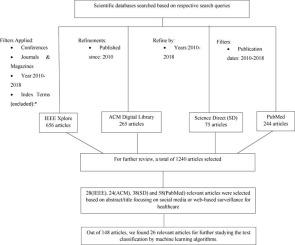Journal of Biomedical informatics ( IF 4.5 ) Pub Date : 2020-07-02 , DOI: 10.1016/j.jbi.2020.103500 Aakansha Gupta 1 , Rahul Katarya 1

|
Background
Real-time surveillance in the field of health informatics has emerged as a growing domain of interest among worldwide researchers. Evolution in this field has helped in the introduction of various initiatives related to public health informatics. Surveillance systems in the area of health informatics utilizing social media information have been developed for early prediction of disease outbreaks and to monitor diseases. In the past few years, the availability of social media data, particularly Twitter data, enabled real-time syndromic surveillance that provides immediate analysis and instant feedback to those who are charged with follow-ups and investigation of potential outbreaks. In this paper, we review the recent work, trends, and machine learning(ML) text classification approaches used by surveillance systems seeking social media data in the healthcare domain. We also highlight the limitations and challenges followed by possible future directions that can be taken further in this domain.
Methods
To study the landscape of research in health informatics performing surveillance of the various health-related data posted on social media or web-based platforms, we present a bibliometric analysis of the 1240 publications indexed in multiple scientific databases (IEEE, ACM Digital Library, ScienceDirect, PubMed) from the year 2010–2018. The papers were further reviewed based on the various machine learning algorithms used for analyzing health-related text posted on social media platforms.
Findings:
Based on the corpus of 148 selected articles, the study finds the types of social media or web-based platforms used for surveillance in the healthcare domain, along with the health topic(s) studied by them. In the corpus of selected articles, we found 26 articles were using machine learning technique. These articles were studied to find commonly used ML techniques. The majority of studies (24%) focused on the surveillance of flu or influenza-like illness (ILI). Twitter (64%) is the most popular data source to perform surveillance research using social media text data, and Support Vector Machine (SVM) (33%) being the most used ML algorithm for text classification.
Conclusions
The inclusion of online data in surveillance systems has improved the disease prediction ability over traditional syndromic surveillance systems. However, social media based surveillance systems have many limitations and challenges, including noise, demographic bias, privacy issues, etc. Our paper mentions future directions, which can be useful for researchers working in the area. Researchers can use this paper as a library for social media based surveillance systems in the healthcare domain and can expand such systems by incorporating the future works discussed in our paper.
中文翻译:

使用机器学习的基于社交媒体的医疗保健监控系统:系统回顾。
背景
健康信息学领域的实时监测已成为全球研究人员日益关注的领域。这一领域的发展有助于引入与公共卫生信息学相关的各种举措。已经开发了利用社交媒体信息的健康信息学领域的监测系统,用于疾病爆发的早期预测和疾病监测。在过去几年中,社交媒体数据(尤其是 Twitter 数据)的可用性实现了实时症状监测,为负责潜在疫情的后续行动和调查的人员提供即时分析和即时反馈。在本文中,我们回顾了最近的工作、趋势、和机器学习 (ML) 文本分类方法,用于在医疗保健领域寻找社交媒体数据的监视系统。我们还强调了在该领域可以进一步采取的可能的未来方向所遵循的局限性和挑战。
方法
为了研究对社交媒体或网络平台上发布的各种健康相关数据进行监测的健康信息学研究概况,我们对在多个科学数据库(IEEE、ACM 数字图书馆、ScienceDirect , PubMed) 从 2010 年到 2018 年。根据用于分析社交媒体平台上发布的与健康相关的文本的各种机器学习算法,对这些论文进行了进一步审查。
发现:
基于 148 篇选定文章的语料库,该研究发现了用于医疗保健领域监控的社交媒体或基于网络的平台的类型,以及它们研究的健康主题。在所选文章的语料库中,我们发现有 26 篇文章使用了机器学习技术。研究了这些文章以找到常用的 ML 技术。大多数研究 (24%) 侧重于监测流感或流感样疾病 (ILI)。Twitter (64%) 是使用社交媒体文本数据进行监控研究的最受欢迎的数据源,而支持向量机 (SVM) (33%) 是最常用的文本分类 ML 算法。
结论
将在线数据纳入监测系统提高了传统症状监测系统的疾病预测能力。然而,基于社交媒体的监控系统有许多局限性和挑战,包括噪音、人口偏见、隐私问题等。我们的论文提到了未来的方向,这对在该领域工作的研究人员很有用。研究人员可以将本文用作医疗保健领域基于社交媒体的监控系统的库,并可以通过结合我们论文中讨论的未来工作来扩展此类系统。



























 京公网安备 11010802027423号
京公网安备 11010802027423号